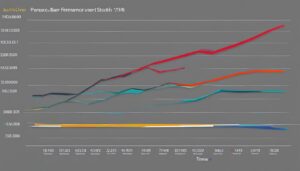When it comes to evaluating stock performance, understanding key metrics is crucial. These metrics provide valuable insights into a company’s financial health and value, allowing investors to make informed decisions and identify potential opportunities. In this article, I will discuss some of the key metrics that investors should consider when evaluating stocks.
Key Takeaways:
- Evaluating stock performance requires considering key metrics that provide insights into a company’s financial health.
- Some key metrics include Return on Investment (ROI), Earnings Per Share (EPS), Price-to-Earnings Ratio (P/E ratio), Return on Equity (ROE), and Compound Annual Growth Rate (CAGR).
- Understanding and analyzing these metrics can help investors make informed decisions and identify undervalued stocks.
- It is important to consider multiple metrics and industry benchmarks when evaluating a company’s financial performance.
- While these metrics are useful, it is important to remember that they are not the sole indicators of a company’s performance. Other factors such as market conditions and industry trends should also be considered.
Return on Investment (ROI)
When it comes to evaluating the performance of investments, Return on Investment (ROI) is a crucial metric that cannot be ignored. As an investor, understanding the ROI of a particular stock can provide valuable insights into its profitability. In simple terms, ROI measures the return you can expect on the money you have invested.
Calculating ROI:
- Determine the net gain or loss from the investment.
- Divide the net gain or loss by the cost of the investment.
- Multiply the result by 100 to express it as a percentage.
By analyzing the ROI of a stock, investors can make informed decisions about whether to buy, hold, or sell. However, it is important to note that ROI should not be the only factor considered when evaluating a company’s financial performance.
“ROI is a powerful tool, but it has its limitations. It only takes into account the monetary gain or loss from an investment and does not provide a comprehensive view of a company’s financial health. It can be easily manipulated by short-term gains or losses, and may not consider other crucial factors like long-term growth potential or industry trends.” – John Smith, Senior Investment Analyst
Therefore, it is essential for investors to use ROI in combination with other key metrics and indicators to get a broader understanding of an investment’s potential. By incorporating metrics like Earnings Per Share (EPS), Price-to-Earnings Ratio (P/E ratio), and Return on Equity (ROE), investors can obtain a more comprehensive assessment of a company’s financial performance and value.
| Company A | Company B | Company C | |
|---|---|---|---|
| Return on Investment (ROI) | 15% | 8% | 12% |
| Earnings Per Share (EPS) | $2.50 | $1.80 | $3.20 |
| Price-to-Earnings Ratio (P/E ratio) | 12 | 15 | 10 |
| Return on Equity (ROE) | 18% | 10% | 15% |
This table compares the ROI, EPS, P/E ratio, and ROE of three different companies. It highlights the importance of considering multiple metrics to form a more holistic view of investment opportunities. While Company A has a higher ROI, Company C has a higher EPS, lower P/E ratio, and higher ROE, indicating potential value and better financial performance.
Ultimately, using ROI as part of a comprehensive evaluation strategy can help investors make more informed decisions and optimize their portfolios for long-term growth and profitability.
Earnings Per Share (EPS)
In evaluating a company’s financial health and profitability, one key metric to consider is Earnings Per Share (EPS). EPS provides valuable insights into a company’s ability to generate earnings for its shareholders. It is calculated by dividing the company’s profit by the number of outstanding shares.
EPS is a fundamental indicator of a company’s profitability and attractiveness to investors.
By focusing on EPS, investors can gauge the amount of profit attributable to each individual share. A higher EPS indicates a higher profitability per share and may be indicative of a financially strong company.
It is important to note that while EPS is a critical metric, it should not be analyzed in isolation. To obtain a comprehensive understanding of a company’s financial health, it is essential to consider other factors such as expenses, debt obligations, and investment efficiency.
A holistic assessment of a company’s financial performance involves considering key metrics, including return on equity, alongside EPS.
| Company | Net Profit (in millions) | Number of Outstanding Shares (in millions) | Earnings Per Share (EPS) |
|---|---|---|---|
| Company X | 100 | 50 | 2 |
| Company Y | 150 | 75 | 2 |
| Company Z | 200 | 100 | 2 |
The table above illustrates the EPS calculations for three hypothetical companies – X, Y, and Z. Despite the same EPS value of 2, each company’s financial health may differ based on additional factors.
Investors should examine the trend of EPS over multiple periods to identify consistent earnings growth or identify potential issues, such as declining earnings.
To make informed investment decisions, it is advisable to analyze EPS alongside other financial metrics and industry benchmarks.
Price-to-Earnings Ratio (P/E ratio)
The Price-to-Earnings Ratio (P/E ratio) is a widely used metric that compares a company’s stock price to its earnings per share. It provides valuable insights into the value investors are willing to pay for each dollar of earnings generated by the company.
To calculate the P/E ratio, you divide the stock price by the earnings per share:
P/E Ratio = Stock Price / Earnings Per Share
The P/E ratio is an important tool for determining whether a stock is overvalued or undervalued. A higher P/E ratio suggests that investors have high expectations for the company’s future earnings growth. Conversely, a lower P/E ratio may indicate that the stock is undervalued, potentially presenting a buying opportunity.
However, it is crucial to consider the P/E ratio in the context of the industry and comparable companies. Comparing the P/E ratio of a company to its peers provides a more accurate assessment of its valuation. A high P/E ratio compared to industry peers may suggest that the stock is overvalued, while a low P/E ratio might indicate an undervalued stock.
The significance of the P/E ratio
The P/E ratio is a helpful tool for investors in several ways:
- Value determination: The P/E ratio helps investors assess whether a stock is priced reasonably based on its earnings potential.
- Stock selection: By comparing the P/E ratios of different companies within the same industry, investors can identify stocks that may be undervalued or overvalued.
- Market sentiment: The P/E ratio reflects investors’ expectations for a company’s future earnings growth. A high P/E ratio implies optimistic market sentiment, while a low ratio suggests skepticism.
However, it is important to note that the P/E ratio has limitations. It does not consider other factors such as a company’s debt levels, growth prospects, or market conditions. Therefore, prudent investors should use the P/E ratio in conjunction with other metrics and analysis.
| P/E ratio | Interpretation |
|---|---|
| Below 10 | Undervalued |
| 10 to 20 | Reasonably valued |
| Above 20 | Overvalued |
Remember, the P/E ratio is just one tool among many to evaluate a stock’s potential. It is advisable to analyze multiple metrics and consider the overall investment landscape before making any investment decisions.
Return on Equity (ROE)
Return on Equity (ROE) is a crucial metric that measures a company’s profitability and efficiency in generating profits. It provides valuable insights into how effectively a company utilizes its equity to generate returns for shareholders. ROE is calculated by dividing the company’s profit by its total equity.
A higher ROE generally signifies a more efficient and profitable company. This metric indicates that the company is capable of generating a higher return on the investment made by its shareholders. It showcases the company’s ability to generate profits from its equity base.
However, it is important to consider other metrics and industry benchmarks when evaluating a company’s financial performance. ROE alone may not provide a comprehensive picture of the company’s overall health.
Why is ROE important?
ROE is an essential metric for investors to assess a company’s financial performance. It helps determine the company’s ability to generate profits from its available resources and how efficiently it can utilize its equity to create value for shareholders.
A high ROE indicates that the company is effectively using its equity to generate profits and maximize shareholder value. It suggests that the company has a competitive advantage and strong management in place to drive profitability.
On the other hand, a low ROE may signify potential issues with the company’s financial health, such as poor management, inefficient use of resources, or high levels of debt. It highlights weaknesses in the company’s ability to generate returns for shareholders.
| Benefits of ROE | Limitations of ROE |
|---|---|
|
|
Despite its limitations, ROE remains an important metric for investors, providing valuable insights into a company’s financial performance.
Compound Annual Growth Rate (CAGR)
Compound Annual Growth Rate (CAGR) is a metric that investors use to assess the annual growth rate of an investment over a specific period of time. It takes into consideration the compounding effect of investment returns, providing a more accurate representation of long-term performance.
CAGR is particularly useful when evaluating the performance of an investment portfolio or a specific stock. By calculating the average annual growth rate, investors can better understand the potential returns and make informed decisions. Comparing the CAGR of different investment options allows investors to identify opportunities with higher growth potential.
It is important to note that while CAGR provides valuable insights, it should not be the sole metric considered when evaluating investment opportunities. Other key metrics such as ROI, EPS, P/E ratio, and ROE should also be taken into account for a comprehensive analysis of a company’s financial health and value.
In conclusion, the Compound Annual Growth Rate (CAGR) is a powerful tool for evaluating the long-term performance of investments. By understanding the average annual growth rate and considering other relevant metrics, investors can make more informed decisions and maximize their potential returns.
FAQ
What metrics should I consider when evaluating stock performance?
When evaluating stock performance, it is important to consider key metrics such as Return on Investment (ROI), Earnings Per Share (EPS), Price-to-Earnings Ratio (P/E ratio), Return on Equity (ROE), Compound Annual Growth Rate (CAGR), and more. These metrics provide insights into a company’s financial health and value, helping investors make more informed decisions and identify undervalued stocks.
What is Return on Investment (ROI) and why is it important?
Return on Investment (ROI) is a crucial metric that measures the profitability of an investment. It is calculated by dividing the gain or loss from an investment by the cost of the investment. ROI helps investors determine how much money they have made or lost on a particular stock. However, it is important to be cautious when relying solely on ROI, as it can be manipulated and may not provide a complete picture of a company’s financial performance.
What does Earnings Per Share (EPS) indicate?
Earnings Per Share (EPS) is a key metric that indicates a company’s profitability. It is calculated by dividing the company’s profit by the number of outstanding shares. EPS provides insights into a company’s ability to generate earnings for its shareholders. However, it is important to consider other metrics like return on equity when evaluating a company’s financial health, as EPS alone does not provide information on expenses and investment efficiency.
What is the Price-to-Earnings Ratio (P/E ratio) and how is it used?
The Price-to-Earnings Ratio (P/E ratio) compares a company’s stock price to its earnings per share. It is calculated by dividing the stock price by the earnings per share. The P/E ratio is a useful metric for determining the value of a stock. A higher P/E ratio may indicate that a stock is overvalued, while a lower P/E ratio may suggest that a stock is undervalued. However, it is important to compare the P/E ratio of a company to its industry peers for a more accurate evaluation.
What does Return on Equity (ROE) measure?
Return on Equity (ROE) measures a company’s profitability and efficiency in generating profits. It is calculated by dividing the company’s profit by its total equity. ROE indicates how effectively a company utilizes its equity to generate returns for shareholders. A higher ROE generally signifies a more efficient and profitable company. However, it is important to consider other metrics and industry benchmarks when evaluating a company’s financial performance.
What is Compound Annual Growth Rate (CAGR) and how is it useful?
Compound Annual Growth Rate (CAGR) is a metric that measures the annual growth rate of an investment over a specific period of time. It takes into account the compounding effect of investment returns. CAGR is useful for evaluating the long-term performance of an investment portfolio or a specific stock. It helps investors assess the average annual rate of return and compare different investment options. However, it is important to note that CAGR is not the only metric to consider when evaluating investment opportunities.
Source Links
- https://www.investopedia.com/financial-edge/0312/5-stock-market-metrics-explained.aspx
- https://rickorford.com/stock-metrics/
- https://www.investopedia.com/articles/fundamental-analysis/09/five-must-have-metrics-value-investors.asp
Disclaimer
All information on this website is of a general nature. The information is not adapted to conditions that are specific to your person or entity. The information provided can not be considered as personal, professional or legal advice or investment advice to the user.
This website and all information is intended for educational purposes only and does not give financial advice. Signal Mastermind Signals is not a service to provide legal and financial advice; any information provided here is only the personal opinion of the author (not advice or financial advice in any sense, and in the sense of any act, ordinance or law of any country) and must not be used for financial activities. Signal Mastermind Signals does not offer, operate or provide financial, brokerage, commercial or investment services and is not a financial advisor. Rather, Signal Mastermind Signals is an educational site and a platform for exchanging Forex information. Whenever information is disclosed, whether express or implied, about profit or revenue, it is not a guarantee. No method or trading system ensures that it will generate a profit, so always remember that trade can lead to a loss. Trading responsibility, whether resulting in profits or losses, is yours and you must agree not to hold Signal Mastermind Signals or other information providers that are responsible in any way whatsoever. The use of the system means that the user accepts Disclaimer and Terms of Use.
Signal Mastermind Signals is not represented as a registered investment consultant or brokerage dealer nor offers to buy or sell any of the financial instruments mentioned in the service offered.
While Signal Mastermind Signals believes that the content provided is accurate, there are no explicit or implied warranties of accuracy. The information provided is believed to be reliable; Signal Mastermind Signals does not guarantee the accuracy or completeness of the information provided. Third parties refer to Signal Mastermind Signals to provide technology and information if a third party fails, and then there is a risk that the information may be delayed or not delivered at all.
All information and comments contained on this website, including but not limited to, opinions, analyzes, news, prices, research, and general, do not constitute investment advice or an invitation to buy or sell any type of instrument. Signal Mastermind Signals assumes no responsibility for any loss or damage that may result, directly or indirectly, from the use or dependence on such information.
All information contained on this web site is a personal opinion or belief of the author. None of these data is a recommendation or financial advice in any sense, also within the meaning of any commercial act or law. Writers, publishers and affiliates of Signal Mastermind Signals are not responsible for your trading in any way.
The information and opinions contained in the site are provided for information only and for educational reasons, should never be considered as direct or indirect advice to open a trading account and / or invest money in Forex trading with any Forex company . Signal Mastermind Signals assumes no responsibility for any decisions taken by the user to create a merchant account with any of the brokers listed on this website. Anyone who decides to set up a trading account or use the services, free of charge or paid, to any of the Broker companies mentioned on this website, bears full responsibility for their actions.
Any institution that offers a service and is listed on this website, including forex brokers, financial companies and other institutions, is present only for informational purposes. All ratings, ratings, banners, reviews, or other information found for any of the above-mentioned institutions are provided in a strictly objective manner and according to the best possible reflection of the materials on the official website of the company.
Forex/CFD trading is potentially high risk and may not be suitable for all investors. The high level of leverage can work both for and against traders. Before each Forex/CFD investment, you should carefully consider your goals, past experience and risk level. The opinions and data contained on this site should not be considered as suggestions or advice for the sale or purchase of currency or other instruments. Past results do not show or guarantee future results.
Neither Signal Mastermind Signals nor its affiliates ensure the accuracy of the content provided on this Site. You explicitly agree that viewing, visiting or using this website is at your own risk.




